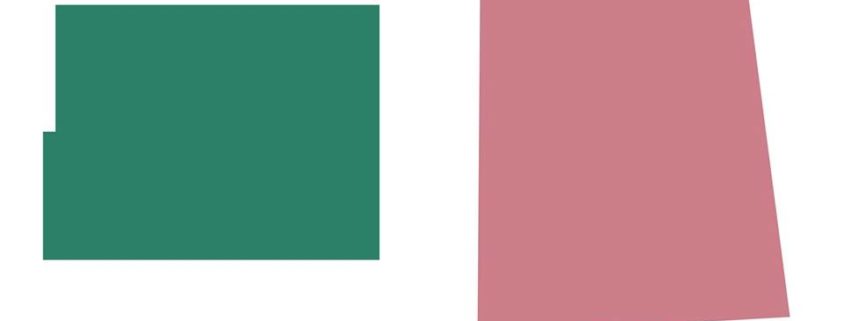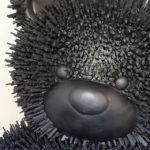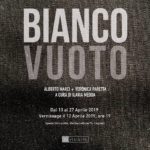Adelaide Cioni e Guy Mees – Galleria P420 – Bologna
Adelaide Cioni e Guy Mees in mostra a Bologna alla Galleria P420: per la prima volta in una doppia personale dal titolo “Shape, color, taste, sound and smell”, curata da Cecilia Canziani
Shape, color, taste, sound and smell
Adelaide Cioni / Guy Mees
a cura di Cecilia Canziani
Inaugurazione venerdì 12 aprile 2019 ore 18-20,30
12 aprile – 1 giugno 2019
P420 Arte Contemporanea
La galleria P420 è lieta di presentare – per la prima volta in una doppia personale – il lavoro dell’artista belga Guy Mees (Mecheln, 1935 – Anversa 2003) e la ricerca dell’artista italiana Adelaide Cioni (Bologna, 1976).
Distanti per geografia e generazione, diversi nell’uso dei materiali, i lavori dei due artisti sono presentati in maniera monografica nelle due sale della galleria in due distinte mostre dallo stesso titolo: Shape, color, taste, sound and smell.
La prima sala raccoglie opere recenti di Adelaide Cioni in lana, flanella e stoffa; acrilico su carta; video. I soggetti sono semplici, diretti e tratti da un immaginario comune che attraversa tanto la cultura vernacolare quanto il linguaggio modernista. Sono immagini iconiche che resistono all’interpretazione e alla narrazione: la trama di un canovaccio è una scacchiera, è un mare, è la griglia compositiva. Un cerchio è un sole o è un buco nero. Una macchia è un fiore – ed è una macchia.
Nella seconda sala è presentato un corpus di opere di Guy Mees appartenenti al ciclo Lost Space e circoscritte agli anni Ottanta e Novanta – ritagli di carta colorata e tela installati direttamente su muro, colore fuoriuscito dalla tela – e un intervento a pastello su carta fotografica che fa parte di una successiva indagine dell’artista sulla relazione tra colore e spazio (e lo spazio fotografato, è bene sottolinearlo, è quello domestico, dunque uno spazio esperienziale e non astratto).
Lost space è anche il nome che Mees aveva dato a una serie di opere realizzate negli anni Sessanta, e di un testo scritto dal regista teatrale Wim Meuwissen sul quale l’artista è tornato facendovi intervenire il copy writer Willem-Joris Lagrillère, affidando una traduzione a Henri-Floris Jespers, e ripensandolo attraverso annotazioni e permutazioni nell’ordine della frase. Il titolo delle mostre è tratto da questo testo.
Lo spazio al quale si riferiscono queste righe – uno dei pochissimi scritti di Mees, notoriamente restio a raccontare il proprio lavoro e concettualizzarlo – è una stanza della sua casa, lasciata vuota, bianca, ma a cui gli amici avevano accesso, una stanza dove “l’artificio è più difficile, la tattilità più semplice”. Questo spazio perduto “definisce solamente il corpo: forma, colore, sapore/suono e odore”.
Shape, color, taste, sound and smell sono quindi, in questa mostra, quelli dello spettatore invitato a un confronto immediato senza sovrastruttura con le opere. Un confronto che è anche corporeo: il mio ingombro di fronte l’ingombro dell’opera, nello stesso luogo.
Le opere di Mees e Cioni, poste una accanto all’altra, ma ciascuna in un luogo che è proprio, chiariscono una comune idea di pittura come colore liberato dal supporto, pura forma autonoma, immagine non narrativa, che si manifesta nella sua relazione diretta e immediata con lo spettatore, nello spazio. Sono poetiche apparentemente semplici, ma che alla grazia lieve dell’immediatezza fanno corrispondere la serietà del gioco, all’apparente spontaneità, la precisione del gesto, alla fragilità e modestia del materiale, una monumentalità luminosa.
Adelaide Cioni è nata nel 1976 a Bologna, ha studiato disegno a UCLA, Los Angeles, e si è diplomata in scultura all’Accademia di Belle Arti di Roma (2015). Laureata in storia contemporanea, per dieci anni ha tradotto letteratura americana (John Cheever, David Foster Wallace, Richard Ford). Nel 2012, terminata la traduzione dei diari di John Cheever, ha deciso di smettere di tradurre per dedicarsi alla pratica artistica. Nel 2014 è stata in residenza alla Citè internationale des arts di Parigi e ha vinto il Premio Celeste. Nel 2015 è stata in residenza a Villa Sträuli, Winterthur. Nel 2016 si è trasferita in Umbria dove, insieme a Fabio Giorgi Alberti, ha aperto uno spazio/studio che si chiama “Franca”. Ha esposto in Italia e all’estero in spazi indipendenti e in luoghi istituzionali, tra cui il MAMbo di Bologna con la mostra personale à propos de bacchelli 5, a cura di Elisa del Prete e Home Movies nel 2015.
Guy Mees è nato nel 1935 a Mechelen, Belgio ed è morto nel 2003 ad Anversa. Il suo lavoro è stato protagonista di numerose mostre personali, tra cui quelle al Palais de Beaux-Arts, Brussels (1990 e 1993); Museum van Hedendaagse Kunst Antwerpen, Anversa (2002); Museum Leuven, Belgio (2012) e recentemente The Weather is Quiet, Cool, and Soft, a cura di Lilou Vidal, alla Kunsthalle Wien Karlsplatz, Vienna (2018) e al Mu.ZEE di Ostenda, BE (2019). Le opere dell’artista sono presenti in numerose collezioni di musei, tra le quali Museum Leuven, Belgio; Museum van Hedendaagse Kunst Antwerpen, Anversa e Musées Royaux des Beaux-Arts de Belgique, Brussels.
Shape, color, taste, sound and smell.
Adelaide Cioni / Guy Mees
curated by Cecilia Canziani
Opening Friday 12 April 2019, 6-8,30 pm
12 April – 1 June 2019
P420 Arte Contemporanea
Galleria P420 is proud to present – for the first time in a double exhibit – the work of the Belgian artist Guy Mees (Mechelen, 1935 – Antwerp 2003) and the research of the Italian artist Adelaide Cioni (Bologna, 1976).
Separated by geography and generation, different in their use of materials, the works of the two artists are presented in individual spaces in the gallery in two distinct exhibits carrying the same name: Shape, color, taste, sound and smell.
The first room contains recent pieces by Adelaide Cioni in wool, flannel and cloth; acrylic on paper and video. The subjects are simple, direct, taken from a collective imaginary that crosses vernacular culture and modernist language. Iconic images that defy interpretation and narration: the pattern of a cloth is a checkerboard, a sea, a compositional grid. A circle is a sun or a black hole. A stain is a flower – and a stain.
The second room features a body of work by Guy Mees belonging to the Lost Space cycle and limited to the 1980s and 1990s – cut-outs of paper and canvas installed directly on the wall, color escaping from the frame – and a work in pastels on photographic paper, part of the artist’s successive study on the relationship between color and space (and the space photographed – it is worth noting – is that of the home, an experiential, non-abstract space).
Lost Space is also the name Mees assigned to a series of works made in the 1960s, and of a text written by the theater director Wim Meuwissen to which the artist returned, calling on the intervention of the copywriter Willem-Joris Lagrillère, entrusting a translation to Henri-Floris Jespers, and rethinking the piece through annotations and permutations of the order of the phrases. The title of the exhibitions is taken from this text. The space referred to by these lines – one of the very few writings by Mees, who was famously reluctant to narrate and to conceptualize his work – is a room in his home, left empty, white, but open to his friends, a room that “makes artifice more difficult, tactility easier”. This lost space “defines only the body: shape, color, taste, sound and smell”.
The Shape, color, taste, sound and smell are therefore those of the viewer, invited to engage in an immediate interaction with the works, without superstructures. An engagement that is also corporeal: my volume in front of the volume of the work, in the same place.
The works of Mees and Cioni, placed side by side, but each in its own location, clarify a shared idea of painting as color freed from its support, pure autonomous form, non-narrative image, manifested in its direct and immediate relationship with the viewer, in the space. Apparently simple poetics, which thanks to the light grace of immediacy make serious play correspond to apparent spontaneity, precision of gesture, fragility and modesty of material, and a luminous monumentality.
Guy Mees was born in 1935 in Mechelen, Belgium and died in 2003 in Antwerp. His work has been the subject of major museum solo exhibitions, including those held at Palais de Beaux-Arts, Brussels (1990 and 1993); Museum van Hedendaagse Kunst Antwerpen, Antwerp (2002); Museum Leuven, Belgium (2012) and recently The Weather is Quiet, Cool, and Soft, curated by Lilou Vidal, at Kunsthalle Wien Karlsplatz, Vienna (2018) and at Mu.ZEE, Ostend, BE (2019). Work by the artist is represented in several museum collections, including Museum Leuven, Belgium; Museum van Hedendaagse Kunst Antwerpen, Antwerp and Musées Royaux des Beaux-Arts de Belgique, Brussels.
Adelaide Cioni was born in 1976 in Bologna, studied drawing at UCLA, Los Angeles, and holds a BA in Sculpture from the Academy of Fine Arts in Rome (2015). With an MA in contemporary history and a master’s degree in Literary Translation (both from the University of Bologna), between 2002 and 2012 she translated American literature for Italian publishers (David Foster Wallace, John Cheever, Richard Ford). In 2012 she completed the translation of John Cheever’s journals for Feltrinelli and decided to quit translating, thereby starting her artistic practice. In 2014 she was resident for six months at the Cité internationale des arts in Paris and won the Premio Celeste. In 2015 she was resident in Villa Sträuli, Switzerland. In 2016 she moved to Umbria, and opened with Fabio Giorgi Alberti an independent space/studio called “Franca”. She has exhibited in independent and institutional spaces, in Italy and abroad, among which a solo exhibition at MAMbo in Bologna: à propos de bacchelli 5, curated by Elisa del Prete and Home Movies in 2015.




